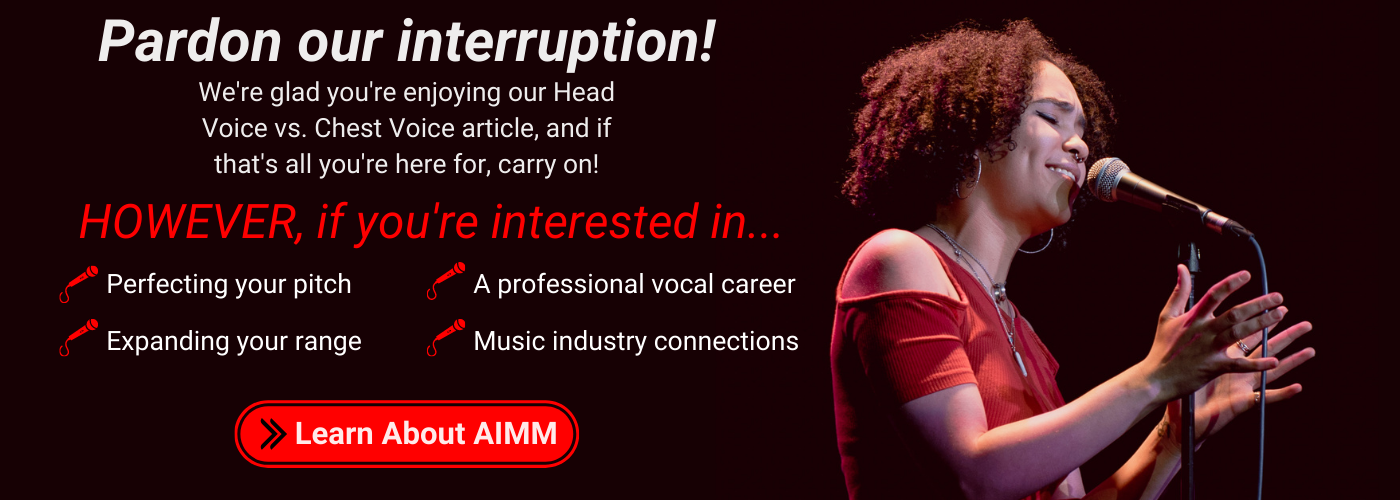Understanding Your Voice
Whether you want to be a famous singer on the grandest stages in the world or just enjoy singing in your car with the radio blasting, most people enjoy belting out a song from time to time.
However, if your goal is the former, then you probably plan on meticulously refining and working on your vocals.
This can be done with the assistance of a vocal coach, working on scales, or just your own personal practice. But there is a chance that during researching you have come across some terms and phrases that are thrown around but never fully explained.
These terms are often "head voice" and "chest voice."
So in terms of singing, how are these different?
- Chest Voice
- Head Voice
- Mixed Voice
- Reach Your Maximum Potential
- Atlanta Institute Of Music And Media
Chest Voice
Chest voice refers to that lower, thicker, and warmer tones. It also reflects the register that we normally use speaking.
When you sing using your normal speaking register, or close to it, put your hand on your chest, and you will feel a vibration. If you have good airflow and are not straining, you should develop a warm tone that doesn't waver or crack. Lack of air flow can cause a low and gravelly sounding tone.
Along with the vibrations you feel, if properly using your chest voice, you will be using the entire mass of your vocal cords.
Issues in terms of being able to use the chest voice often come with a lack of energy. To achieve the depth necessary with your chest voice, you cannot be timid. A significant amount of effort, power, and airflow must be utilized for the sound to resonate correctly.
If you're singing and a few higher notes come up, and you try to "push for it" in your chest voice, your voice may break, lose its tone, or fall flat.
In instances like this, you need to shift to your...
Head Voice
Regardless of how this phrase comes across, the sound does not actually come from your head. Your vocal cords are still very much at play here.
However, when a singer starts reaching up to those higher notes, they may feel the sound and vibration in their head.
Therefore, it is described as the head voice.
Important note: Head voice is not a term interchangeable with falsetto. Falsetto has an airier quality and not quite as full as your chest or head voice. It is a stylistic choice and can be quite effective, but should not be consistently implemented for the sake of your voice. Check out this great article discussing differences between Head Voice and Falsetto.
It is necessary to develop a head voice for your upper range. With the exclusion of occasional belting, higher notes will utilize your head voice.
However, using your head voice can be tricky. It won't initially be as powerful or natural to you like your chest voice; you need to fully support your airflow.
Forming a strong head voice that helps you seamlessly reach those notes out of your chest voice's reach is immensely beneficial to a vocalist. Once you have reached a level of comfort in your head voice, you will be less likely to strain your voice attempting a higher note.
So what if you mix your head voice and chest voice?
Mixed Voice
The ultimate goal is to be able to blend and switch between your head voice and chest voice. This is your mixed voice.
Being able to successfully navigate between your head and chest voice will help you:
- Create your own sound that is best suited for you
- Perform music that doesn't rely too heavily on only chest or head. Flexibility is always a good thing.
Your mixed voice isn't something that just happens. If singing was naturally easy for everyone then our favorite musicians wouldn't be as special. You have to practice at it.
Don't forget to relax, massage, and warm up your facial muscles. The same way an athlete stretch before a game, you need to take care of your vocals.
Your voice is a muscle, so adequate exercises, rehearsal, and time is needed to reach the goals you set for yourself.
Get a Vocal Advantage
When deciding whether or not to use your "head voice" or your "chest voice," don't over the stress. The key is to hit the note and reach it comfortably.
You want to be able to possess a clean, warm sound and whichever method makes that happen for you is your best bet. There is no cut and dry answer. Every person is different, and this is no exception.

If you want top-notch training from successful professors, consider the Atlanta Institute of Music and Media.
AIMM has multiple vocal programs, so whether you want to focus entirely on your performance or want to learn how to produce music as well, we have you covered!
Want to be sure that AIMM aligns with your singing career goals? Click below for a Free Online Intro Course, and discover how AIMM can benefit your music career today.
Additional Articles:















